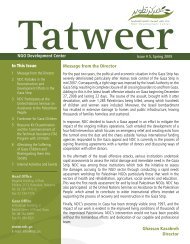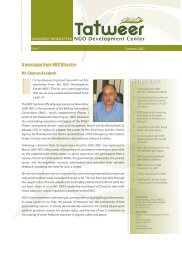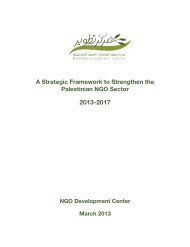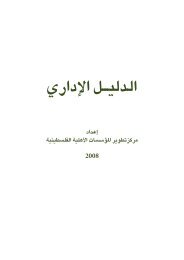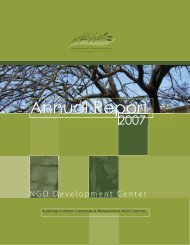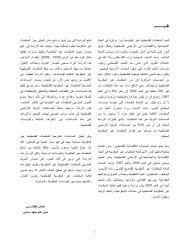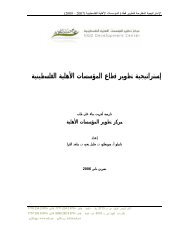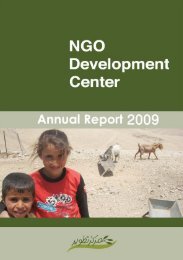Tracking External Donor Funding.pdf - NDC
Tracking External Donor Funding.pdf - NDC
Tracking External Donor Funding.pdf - NDC
Create successful ePaper yourself
Turn your PDF publications into a flip-book with our unique Google optimized e-Paper software.
Strip. In the West Bank, President Abbas appointed an<br />
emergency ‘technocratic’ government, who after<br />
exceeding its 60 day became known as the ‘caretaker<br />
government’.<br />
According to the MoP, ‘the Caretaker Government is<br />
favorably viewed by the international community, and<br />
(its appointment) led to an immediate reversal of donor<br />
financial sanctions and no-contact policies (with the PA).<br />
<strong>Donor</strong>s reengaged with the PA in the West Bank on a<br />
development agenda (…) However, this donor-PA<br />
engagement is limited to the West Bank – in the Gaza<br />
Strip, aid remains purely humanitarian’ (ibid).<br />
‘<strong>Donor</strong> re-engagement’ in the West Bank, as described<br />
by the MoP, is an understatement when one looks at the<br />
trends in external aid to both the WB&GS in general and<br />
PNGOs in particular. Through frameworks such as<br />
Temporary International Mechanism (TIM) and INGOs,<br />
aid to Palestine as a whole and the PNGO sector in<br />
particular, actually increased dramatically between 2006<br />
and 2008 despite the embargo.<br />
2.1.3 In Focus: From TIMS to PEGASE<br />
Following the 2006 elections, the EU established a mechanism that tried to meet the basic needs of the Palestinians while by<br />
passing the coffers of the Hamas-led PA. The expenditures to be covered were limited to three Windows:<br />
Window I:<br />
Essential supplies and approved recurrent non-wage expenditures for the health sector, and basic allowances to health care<br />
service providers who had not been receiving salaries 20 ;<br />
Window II:<br />
Support for uninterrupted supply of utilities, including fuel; and<br />
Window III:<br />
Basic needs allowances to meet the essential needs of the poorest segments of the population.<br />
The aid that did come through these windows came attached with important preconditions. Contact with the PA was to only<br />
take place at the ‘lowest possible levels’, with the Office of the President acting as the only interface for the management<br />
unit of the TIM and charged with signing and ratifying all legal agreements. Furthermore, international banks were selected<br />
to pay eligible expenditures directly to Palestinians within an agreed-upon process for validation, certification and<br />
oversight 21 .<br />
In February 2008, seven months after the formation of the Emergency Government, the TIM was replaced by the PEGASE, a<br />
new aid channeling mechanism that aligned to the key priorities of the Palestinian Reform and Development Plan (PRDP) 22 .<br />
In the words of the European Commission,<br />
‘The European Union is strongly committed to support the Palestinian Authority’s reform and development priorities<br />
aiming at boosting the economy and improving the life of all Palestinians. PEGASE will provide greater stability and<br />
predictability to our action as the largest donors to the Palestinians and emphasize the ownership of the Palestinian<br />
Authority in the process of reform and development.’ 23<br />
Unlike the annual TIM, the PEGASE has a schedule of three years, the same length as the PRDP. A second difference is that<br />
rather than flowing through the OoP, the PEGASE shifted toward the Ministry of Finance and the PMO, both headed by Dr<br />
Salaam Fayyad.<br />
Distribution<br />
Since June 2006, the European Commission has contributed €455.5 million to the TIM, with further contributions coming<br />
from individual EU Member States, Norway and Switzerland (€157.5 million). Since its establishment in February of 2008,<br />
PEGASE has disbursed €409 million out of the €550 million pledged. The mechanism has channeled a further €131 million<br />
from other donors and EU Member States.<br />
20<br />
21<br />
22<br />
23<br />
By 2006, the salaries of 172,000 public employees constituted 60% of the PA’s budget (Aronson, 2006)<br />
Critics of the TIM mechanism, such as Oxfam (2007), have pointed to the fact that 'more than a million Euros of European aid for Palestinians is<br />
being paid to the HSBC bank each month in bank charges for transferring allowances to over 140,000 Palestinians'.<br />
PEGASE channels aid through five different payment systems, tailored to match the nature of each activity. <strong>Donor</strong>s can contribute to any of these,<br />
depending on their priorities and their specific requirements.<br />
EC Press Release (2007). Commission launches PEGASE – a new mechanism to support the Palestinian people.<br />
10


